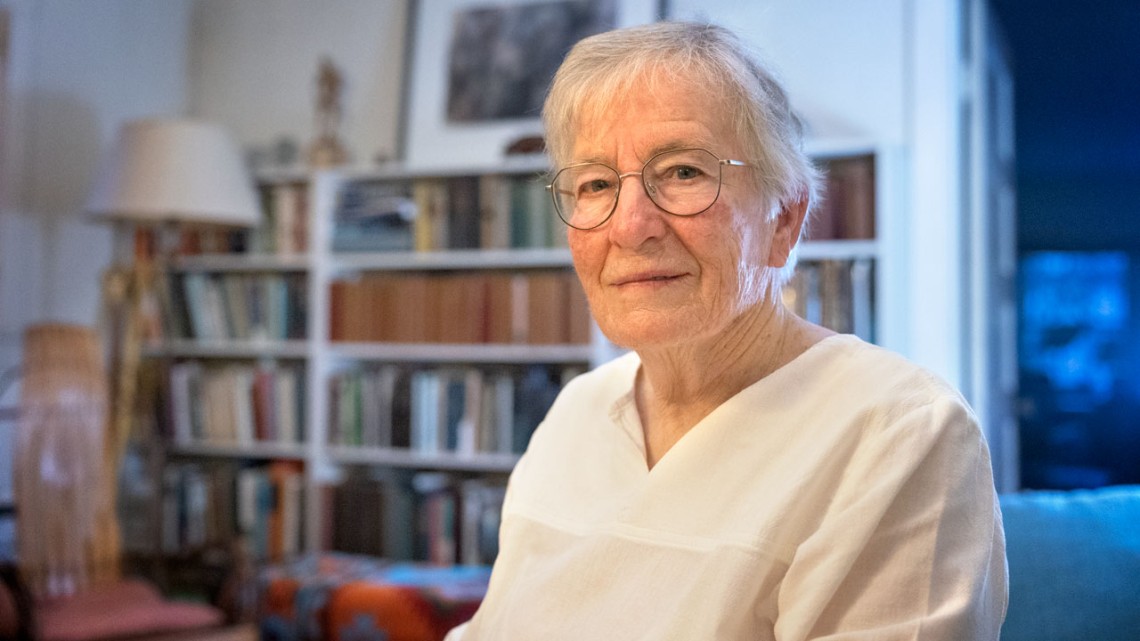
Katy Payne ’59, a pioneer in the burgeoning science of bioacoustics.
Unique fellowship honors bioacoustics pioneer
By Pat Leonard
Retired Cornell researcher Katy Payne ’59 has spent much of her career sitting quietly and listening. But her many accomplishments speak volumes about her foundational role in the burgeoning science of bioacoustics – listening to and studying the sounds of Earth’s creatures – and now she has been duly recognized for them.
During a recent dinner with the administrative board of the Cornell Lab of Ornithology, philanthropist K. Lisa Yang ’74 announced an endowment of $1.5 million to establish the Katharine B. Payne Fellows Program in Conservation Bioacoustics.
This fellowship will be offered through the K. Lisa Yang Center for Conservation Bioacoustics at the Lab of Ornithology. And there’s a twist: Selected fellows need not have an advanced degree to qualify.
“Humans possess talent regardless of a lack of formal training, education or academic letters behind their name,” Yang said during the announcement. “This endowment will enable the Yang Center to further build capacity in areas of high biodiversity where students are constrained by economic challenges. For too, too long, Katy’s seminal contributions to this field have gone unacknowledged … but not anymore. Katy, you are indeed a giant in bioacoustics history.”
“The Yang Center will now be able to offer ongoing support to fellows wishing to implement conservation where it is needed,” Payne said. “It’s appropriate that they need not start off with advanced academic degrees. Their selection will reflect the level of their passion and the diaspora of bioacoustics training programs they have attended.
“Many will know local conservation challenges from firsthand experience,” Payne said. “We have much to learn from them. It’s thrilling to think of the many kinds of fruitful interactions that will follow.”
Despite her own lack of a Ph.D., Payne made groundbreaking discoveries that sprang from her patience, music background and keen listening skills. With fellow researchers, she heard not only the previously unknown songs of humpback whales but realized that, over time, they were evolving.
She discovered that elephants make long distance calls using infrasound (too low for human ears to hear) and made it the subject of her 1998 book, “Silent Thunder: In the Presence of Elephants.” She helped establish the Elephant Listening Project within the Lab of Ornithology, using sound to understand endangered African forest elephants and their complex society – and to protect them from the ravages of poaching.
Holger Klinck, the John W. Fitzpatrick Director of the Yang Center, called Payne an “inspiration” in the world of bioacoustics.
“As indicated by my gray hair, I have been around the block a few times and worked in the field for several decades,” he said. “So, I hope you believe me when I say that Katy’s contributions to the field of bioacoustics are equal to Jane Goodall and Sylvia Earle’s contributions to the fields of primatology and oceanography.”
Said Russ Charif, a longtime colleague and bioacoustics researcher: “Scientists in the Yang Center and around the world continue to build on Katy’s discoveries, deepening our understanding of culture in non-human animals and developing new ways of studying and conserving endangered wildlife by eavesdropping on their sounds. Katy, we thank you for your lifetime of listening, and for sharing your insights and wisdom.”
Pat Leonard is a writer for the Cornell Lab of Ornithology.
Media Contact
Get Cornell news delivered right to your inbox.
Subscribe
